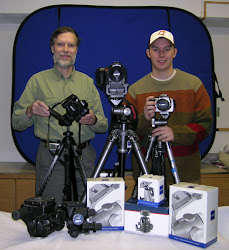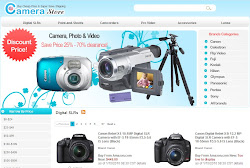When choosing a digital camera for travel, the choice of available models can be overwhelming. Here are five crucial factors to help you decide on the most suitable digital camera for your particular travel needs.
1. Type of Travel
a) Organized tour with transport arranged and secure baggage handling -- you can afford to take a bigger, more expensive camera as you'll be traveling in a group with good security, so you can carry a camera round your neck or on your lap when traveling.
Recommended: a good quality digital compact camera with at least a 3x zoom lens, but preferably a 10x zoom for more flexibility; if budget allows, a digital SLR with one or two lenses as you will be able to carry a separate camera case.
b) Independent traveler, making your own way, using public transport -- security will be a problem and you want to carry as few bags as possible.
Recommended: small, compact digital camera that can be stowed in a pocket or hand-bag. Don't go overboard and buy a very tiny camera, as you pay a premium for these. Today, small digital compacts with 3x zoom lens are capable and affordable.
c) Budget, back-packing, staying in hostels -- you'll be traveling light with minimal carrying capacity, with security a potential problem.
Recommended: small, inexpensive, inconspicuous compact you can keep in a pocket or fanny pack with other valuables like your passport. Cut down on fancy features such as extra megapixels or face recognition, but do go for 3x zoom for flexibility.
2. Nature of Trip
a) Vacation to a beach or resort hotel -- security should not be a problem, so you can carry a camera bag, allowing more gear.
Recommended: most shots will be scenics -- pictures on the beach or around the pool, plus people pictures, so don't need a powerful 10x zoom lens. Rather go for a 3x zoom that's as wide as possible at the wide end of the zoom. You can fit a lot more into a picture at 28mm (equivalent) focal length than at 35mm. Alternatively, if budget allows, a digital SLR with a wide angle zoom lens, but can be a burden to carry around.
b) Emphasis on sightseeing, visiting historical sites -- need flexibility with big zoom range, from wide angle to telephoto.
Recommended: digital compact with 10x or 12x zoom that allows you to zoom out wide for expansive shots, as of cathedral exteriors and interiors, then lets you zoom in on the details. Also useful for urban/street photography, so you can sit at a café sipping coffee and take a variety of photos, from buildings to candids of buskers, without having to move.
c) Outdoors, safari -- if a rugged hiking trip, then weight is paramount, but less so if going on an African safari.
Recommended: for walking or hiking in the mountains, a light, rugged, digital compact with a 3x or 5x zoom lens for taking scenics and informal shots of your travel companions. For safari, if you want to capture the wildlife and not just the countryside, then a compact superzoom (10x or more zoom range) is a good choice as you'll be viewing game from a vehicle where space can be tight. If you're serious about your wildlife images, then a digital SLR is the way to go, but try to keep lenses down to two because of space constraints.
3. Your Interests
a) Buildings, architecture, historical sites -- need wide angle capability to include exteriors of large buildings and tight interiors.
Recommended: digital compact with good built-in flash, plus ability to shoot at high ISO for interior shots without flash. Where possible go for image stabilization, allowing slow shutter speeds in dim light. Must have a 3x zoom at the minimum, as wide as possible on the wide end, or even 10x zoom for taking in detail -- but again make sure it's as wide as possible when zoomed out, e.g. 28-280mm rather than 35-350mm.
b) People, locals, candid shots, reportage -- need telephoto capability so can shoot from a distance, unnoticed.
Recommended: definitely a 10x to 12x zoom with emphasis on the telephoto rather than wide angle side. Preferably a black camera that's not too bulky and conspicuous. A small digital SLR is an alternative, but you'll need two lenses to cover the range you'll get with a compact superzoom.
c) Local countryside, landscapes, agriculture -- wide angle will be important and generally you won't need a strong telephoto lens.
Recommended: digital compact with 3x zoom should be fine, but select one that offers the widest angle within the zoom range.
4. Your Budget
a) It's not an issue -- go for a good digital SLR with at least two lenses; alternatively, a top-of-the-range compact digital with wide zoom range. A recommended SLR choice would be a Canon entry-level Digital Rebel SLR with a couple of Canon EF-S lenses, like the EF-S 18-55mm f3.5-5.6 plus EF-S 55mm-250mm f4-5.6 IS, giving you a 35mm equivalent focal length range of 28 to 400mm.
b) Up to $300 -- if size is not an issue, then go for a 10x or more zoom as these cameras offer the most flexibility. Can use at home for group shots, candid portraits, and sport.
c) Tight, $200 maximum -- there are plenty of very capable cameras in this range, so look for a recognized brand name (Panasonic, Sony, Olympus, Pentax, Nikon, Canon), skip fancy features like extra megapixels and go instead for benefits like optical zoom in the 3x or 5x range, and rechargeable batteries with charger included.
5. Picture Use
a) Share with friends by email, on Facebook, have postcards printed. Here quality is not an issue, so any modern compact digital camera will suffice, even the cheap ones.
b) Same as above, but also want to blow up some of your photos to hang on walls, have calendars made. In this case, image quality is important, so you'll need a camera with a good lens and, if possible, the ability to shoot at higher ISO without excessive "noise" becoming visible. Here digital SLR cameras can't be beaten as they keep noise down at higher ISO settings while also allowing you to crop images and still make big blow-ups.
Thanks To : Cheap Handbags4u







0 comments:
Post a Comment